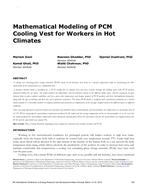Description
A cooling vest containing phase change materials (PCM) made of salt mixtures that melts at a specific temperature helps in maintaining the skin temperature of the covered parts at a comfortable level.
A dynamic thermal model is developed for a PCM cooling vest to simulate heat and mass transfer through the clothing layers with PCM packets integrated within the air layers. The model predicts the temperature and the moisture content of the different fabric layers and the associated air gaps between them at given ambient conditions and for a given skin temperature and known number of PCM packets and their thermophysical properties along with the type of clothing and their dry and evaporative resistances. The fabric-PCM model is validated with experiments performed on a clothed heated cylinder in a controlled chamber to compare predicted and measured air temperatures of the air gaps trapped between the different layers at different conditions.
There was good agreement in general between the measured and predicted values of microclimate and macroclimate air temperatures at maximum error of +/- 3.5%. When comparing the macroclimate temperature predicted by the model and the average temperature of the six thermocouples, it can be seen that the model predicted the macroclimate temperature better during the melting phase where the maximum error for the macroclimate air trapped between the PCM and the outer fabric was around 3%.
Keywords: Phase Change Material; modeling passive cooling vest; transient heat transfer in fabric and PCM.
Citation: 6th International Conference on Energy Research and Development, State of Kuwait, March 14–16, 2016
Product Details
- Published:
- 2016
- Number of Pages:
- 8
- Units of Measure:
- Dual
- File Size:
- 1 file , 1.7 MB
- Product Code(s):
- D-ICER16-17




